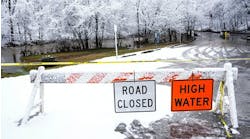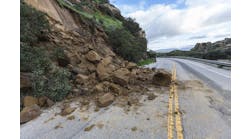By: By Paul Carlson; Contributing Author
As early as the 1920s highway agencies across the country started developing guidelines for uniform traffic signs. During that time—and pretty much ever since—the conventional thinking concerning nighttime visibility has been brighter is better.
That is because nighttime sign visibility has been lacking that of daytime sign visibility.
In the 1920s they might have been developing uniform sign shapes and colors, but the signs were simply painted, and their nighttime visibility was poor. In the 1930s, retroreflective cat’s eyes were beginning to be used in the letters and borders of signs, but the nighttime color of the sign was lost. In the 1950s, microsize glass beads were added to the paint to make the entire surface of the sign retroreflective, allowing the daytime color of the sign to be seen at night.
In the 1990s, microsize cube-corner retroreflectors were beginning to be used in favor of microsize glass beads because they provided brighter signs at night. The microsize-cube-corner technology has evolved over the last couple of decades so that signs today are brighter than ever—maybe even too bright in some situations. A recent Texas A&M Transportation Institute (TTI) research project has revealed that signs along rural highways can be so bright that they cause disability glare to the point of limiting detection distances of potential roadside hazards—and that can be a significant safety concern.
The project, co-sponsored by the Federal Highway Administration (FHWA) and the Texas Department of Transportation, provided a unique opportunity to study a new aspect to retroreflective signs. Most, if not all, of the recent research related to traffic-sign visibility has been focused on establishing recommendations for the minimum brightness signs needed in order for nighttime road users to see and read them in time to safely react. Much of this research has been used by the FHWA to set minimum retroreflectivity maintenance levels for all traffic signs in the U.S. These minimum retroreflectivity maintenance levels are published in the Manual on Uniform Traffic Control Devices (MUTCD) and went into effect as of June 2014.
Chinks in the gleaming armor
The idea for this project has developed over several years. While the FHWA was developing minimum traffic-sign-retroreflectivity levels, there were some technology changes in the market, and manufacturers and contractors started pushing for brighter signs, while agencies were replacing those that were not in compliance with the minimum retroreflectivity rule. The newest sign materials were being used, and the signs were brighter than ever. That is when TTI started hearing complaints from agencies throughout the country asking if these signs can be too bright. That question had never really been asked before.
The problem with very bright signs is that they can be so bright that there may be a loss of legibility or a glare so strong that it limits the driver’s ability to see potentially hazardous objects near or on the road. In order to find out, the researchers conducted a nighttime study by recruiting participants and conducting nighttime visibility studies on a closed-course facility at the Texas A&M University Riverside Campus, a retired Air Force base.
In the research study, 23 nighttime drivers (12 were 60 years or older and the remaining 11 were less than 36 years old) drove around a 12-mile roadway course looking for speed limit signs and various types of potentially hazardous objects along the edge of the traveled way. The nighttime drivers were asked to read the speed limit signs as soon as they could. They also were asked to identify the roadside hazards as soon as they could.
The speed limit signs were made of two types of retroreflective materials (one material used microsize glass beads and another material used the latest version of microsize cube corners, commonly referred to as ASTM D4956 Type III and Type XI, respectively). The roadside hazards ranged from a deer decoy to a pedestrian to a small piece of wood (too large for most vehicles to straddle). All of the roadside hazards were located 3 ft outside of the edge line marking the travel lane. The locations of the speed limit signs and roadside hazards varied throughout the visibility testing.
The study was conducted exclusively with high-beam lighting to represent the conditions of low-volume rural highways.
More than 1,200 data points were generated regarding nighttime drivers’ ability to detect potentially hazardous roadside objects. As expected, the younger drivers were able to detect objects farther than the older drivers. In order to determine a baseline, some of the object-detection tasks were designed with no speed limit sign in view. The farthest detection distances were recorded when no sign was present. When the signs were present, the detection distances decreased—and the brighter the sign, the shorter the detection distances.
Besides detection distances, the research team also evaluated the legibility of speed limit signs. Somewhat surprisingly, the legibility distances of these signs were not very different (with averages of 444 ft for the glass-bead signs and 432 ft for the cube-corner signs). At some point, very high sign brightness can degrade sign legibility too. However, for these types of signs, the sign brightness had relatively little to no practical impact on sign legibility. For reference, the maximum luminance of the material with glass beads was measured at nearly 200 cd/sq meter and more than 500 cd/sq meter for the material with cube corners.
Regarding recommendations, the researchers point out that the detection-distance results suggest agencies should consider removing unnecessary signs because of the potential for glare and degraded ability to detect objects in the vicinity of the signs. In addition, removal of unnecessary signs can alleviate maintenance needs and remove potential roadside hazards.
The researchers also recommend using ASTM D4956 Type III or Type IV sign-sheeting materials on rural highways with average daily traffic less than or equal to 5,000 vehicles per day. The 5,000 vehicle-per-day threshold was derived from analysis of when selection of high beam use is likely.
Customized complexity
Making decisions about traffic-sign materials is more complex than ever. Regarding retroreflective materials, the concept of one-size-fits-all is appealing but probably does not serve the nighttime driver as well as selecting materials based on the nighttime driver needs and the environment where they will be used. While the TTI research summarized here provides some insight, there are no nationally recognized guidelines for agencies to help select traffic-control materials for signs. Factors that should be considered include the type of highway, the volume, the type of vehicles, the roadside development, material costs and material durability. Minimizing nighttime glare on a rural highway with a dense population of wildlife such as deer can help reduce crashes and possibly save lives. However, providing bright signs in urban areas so that drivers can read and react in a timely fashion also can help save lives.
The research team hopes to eventually develop guidelines for sign-sheeting selection that include maximum retroreflective standards to complement the minimum retroreflectivity levels that are already established in the MUTCD. The team also plans on testing more headlight patterns to better understand how future technologies might impact the safety of nighttime travel. ST


